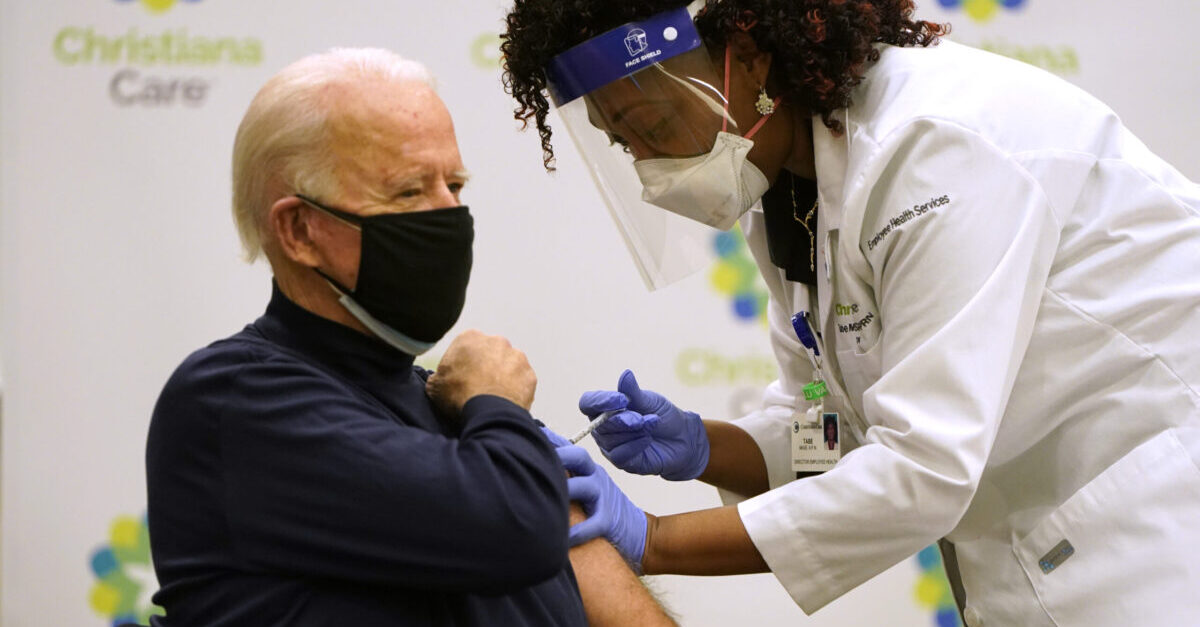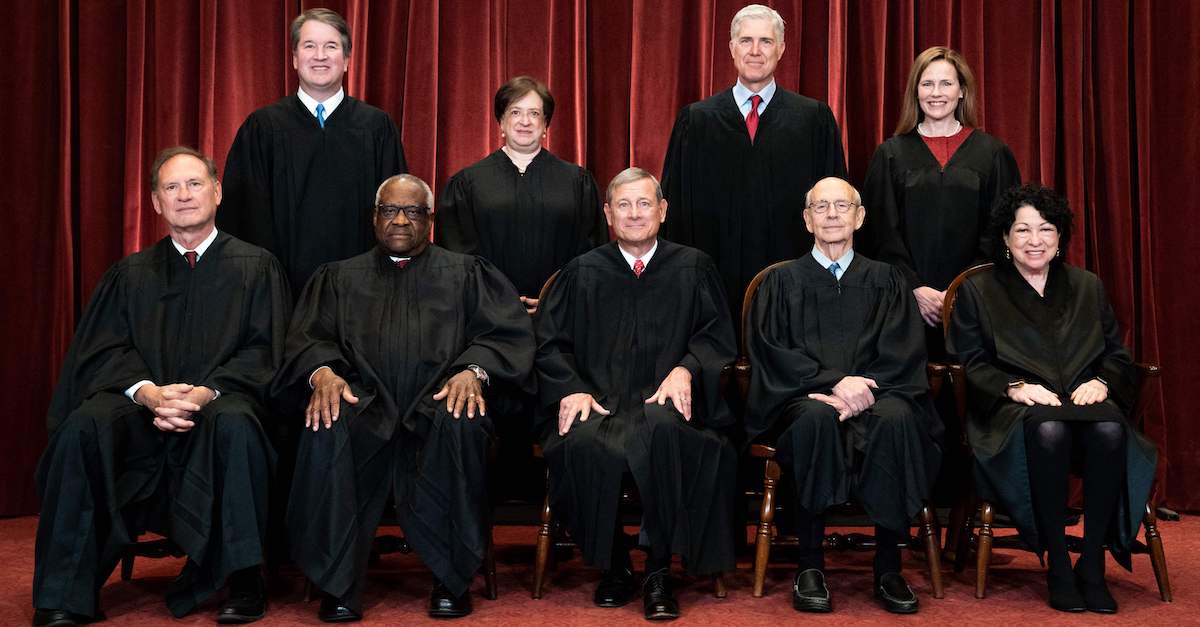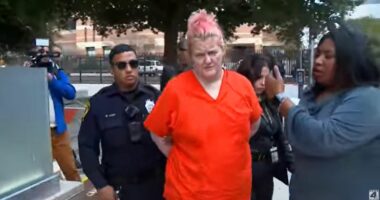Share this @internewscast.com

Then-president-elect Joe Biden received a COVID-19 vaccination from nurse practitioner Tabe Mase at ChristianaCare Christiana Hospital on December 21, 2020 in Newark, Del.
The Supreme Court of the United States on Thursday issued a stay against a generalized workplace COVID-19 vaccination mandate championed by the administration of President Joe Biden — but it allowed a similar mandate involving only Medicare and Medicaid providers to go into effect. The ripple effects, the decisions themselves noted, will affect millions of workers around the country.
The court issued edits both matters as unsigned per curiam decisions. We will discuss each decision in turn below. Both pitted the high court’s liberal justices against the court’s conservatives. Chief Justice John Roberts and Justice Brett Kavanaugh provided the swing votes that kept the mandate for health care workers in effect; both justices voted to rubbish the mandates for non-health care workers in general.
The Workplace Mandate
The general workplace mandate was aimed at large employers and was promulgated by OSHA, the Occupational Safety and Health Administration. At issue in the case was not the efficacy of the vaccines themselves or the seriousness of the pandemic — but rather whether OSHA had the authority to require inoculations via the Administrative Procedure Act.
The court skewered OSHA for using its power to implement “emergency temporary standards” to pass a vaccine mandate.
“Prior to the emergence of COVID-19, the Secretary [of the Department of Labor] had used this power just nine times before (and never to issue a rule as broad as this one),” the high court noted. “Of those nine emergency rules, six were challenged in court, and only one of those was upheld in full.”
The court was not about to grant the Biden Department of Labor a win in this matter.
“The regulation . . . operates as a blunt instrument,” the justices said. “It draws no distinctions based on industry or risk of exposure to COVID–19. Thus, most lifeguards and linemen face the same regulations as do medics and meat-packers. OSHA estimates that 84.2 million employees are subject to its mandate.”
The court also skewered OSHA for passing such sweeping unique and novel regulations given the agency’s core mission (emphases in the original):
As its name suggests, OSHA is tasked with ensuring occupational safety — that is, “safe and healthful working conditions.” It does so by enforcing occupational safety and health standards promulgated by the Secretary. Such standards must be “reasonably necessary or appropriate to provide safe or healthful employment.” They must also be developed using a rigorous pro- cess that includes notice, comment, and an opportunity for a public hearing.
“It is telling that OSHA, in its half century of existence, has never before adopted a broad public health regulation of this kind—addressing a threat that is untethered, in any causal sense, from the workplace,” the court later said.
In other words, OSHA’s leaders under the Biden Administration stretched their regulatory mandates too far beyond the pale, the court rationed.
The court was also moved by complaints from a collection of politically conservative state administrations and from employers — which suggested they collectively were being forced “to incur billions of dollars in unrecoverable compliance costs and will cause hundreds of thou- sands of employees to leave their jobs.”
“Although Congress has indisputably given OSHA the power to regulate occupational dangers, it has not given that agency the power to regulate public health more broadly,” the majority decided. “Requiring the vaccination of 84 million Americans, selected simply be- cause they work for employers with more than 100 employees, certainly falls in the latter category.”
The court’s opening salvo retraced the history of the mandate and the procedure used to accomplish it.
The Secretary of Labor, acting through the Occupational Safety and Health Administration, recently enacted a vac- cine mandate for much of the Nation’s work force. The mandate, which employers must enforce, applies to roughly 84 million workers, covering virtually all employers with at least 100 employees. It requires that covered workers receive a COVID–19 vaccine, and it pre-empts contrary state laws. The only exception is for workers who obtain a medical test each week at their own expense and on their own time, and also wear a mask each workday. OSHA has never before imposed such a mandate. Nor has Congress. Indeed, although Congress has enacted significant legislation ad- dressing the COVID–19 pandemic, it has declined to enact any measure similar to what OSHA has promulgated here.
Justices Neil Gorsuch, Samuel Alito, and Clarance Thomas concurred:
The central question we face today is: Who decides? No one doubts that the COVID–19 pandemic has posed challenges for every American. Or that our state, local, and national governments all have roles to play in combating the disease. The only question is whether an administrative agency in Washington, one charged with overseeing work- place safety, may mandate the vaccination or regular test- ing of 84 million people. Or whether, as 27 States before us submit, that work belongs to state and local governments across the country and the people’s elected representatives in Congress. This Court is not a public health authority. But it is charged with resolving disputes about which authorities possess the power to make the laws that govern us under the Constitution and the laws of the land.
The court’s three liberal justices — Stephen Breyer, Sonia Sotomayor, and Elena Kagan — predictably dissented by pointing squarely to the workplace effects of COVID-19:
Every day, COVID–19 poses grave dangers to the citizens of this country—and particularly, to its workers. The disease has by now killed almost 1 million Americans and hospitalized almost 4 million. It spreads by person-to-person contact in confined indoor spaces, so causes harm in nearly all workplace environments. And in those environments, more than any others, individuals have little control, and therefore little capacity to mitigate risk. COVID–19, in short, is a menace in work settings. The proof is all around us: Since the disease’s onset, most Americans have seen their workplaces transformed.
“In our view, the Court’s order seriously misapplies the applicable legal standards,” the dissent later said in blistering fashion. “And in so doing, it stymies the Federal Government’s ability to counter the unparalleled threat that COVID–19 poses to our Nation’s workers. Acting outside of its competence and without legal basis, the Court displaces the judgments of the Government officials given the responsibility to respond to workplace health emergencies.”
Elsewhere, the dissent said OSHA officials were “well within the scope of their authority” to pass the regulation on an emergency basis.

The Medicare and Medicaid Mandate
Another of the Biden Administration’s Covid vaccine mandates involved swiftly enacted “interim final” rules aimed at medical providers compensated through the federal CMS, or Centers for Medicare and Medicaid, systems. The court allowed the health care provider mandates to fully take effect — but by a narrow 5-4 margin.
Justices Thomas, Alito, Gorsuch, and Amy Coney Barrett issued a dissent. The per curiam majority was therefore made up of Chief Justice Roberts and justices Kavanaugh, Breyer, Kagan, and Sotomayor.
Kavanaugh and Roberts were the swing votes, and both swung together.
“In November 2021, the Secretary [of Health and Human Services, or HHS] announced that, in order to receive Medicare and Medicaid funding, participating facilities must ensure that their staff — unless exempt for medical or religious reasons — are vaccinated against COVID–19,” the court noted. “Two District Courts enjoined enforcement of the rule, and the Government now asks us to stay those injunctions. Agreeing that it is entitled to such relief, we grant the applications.”
Here, the court decided, “the most basic” function of the Department of Health and Human Services was “to ensure that the healthcare providers who care for Medicare and Medicaid patients protect their patients’ health and safety.” The court concluded that a clear Congressional mandate was at play in health regulations promulgated by HHS pursuant to Medicare and Medicaid funding. Specifically, “Congress authorized the Secretary to promulgate, as a condition of a facility’s participation in the programs, such ‘requirements as [he] finds necessary in the interest of the health and safety of individuals who are furnished services in the institution,”” the court noted.
Or, in other words, CMS/HHS had the power to pass these mandates.
With what appears to be a nod to the preceding generalized workplace mandate decision, the court concluded:
The challenges posed by a global pandemic do not allow a federal agency to exercise power that Congress has not conferred upon it. At the same time, such unprecedented circumstances provide no grounds for limiting the exercise of authorities the agency has long been recognized to have. Because the latter principle governs in these cases, the applications for a stay presented to JUSTICE ALITO and JUSTICE KAVANAUGH and by them referred to the Court are granted.
The four-justice dissent by the aforementioned collection of conservative jurists — with Thomas leading the charge — argued that the Biden administration had “not made a strong showing that it has statutory authority to issue the rule” at issue.
“Covered employers must fire noncompliant workers or risk fines and termination of their Medicare and Medicaid provider agreements,” the dissent wrote. “As a result, the Government has effectively mandated vaccination for 10 million healthcare workers.”
The dissent also accused government lawyers of citing a mere “hodgepodge of provisions” as support for the mandate.
Thomas, et al., nonetheless conceded the broader point about the importance of vaccines while pointing readers to the narrow issue at play:
These cases are not about the efficacy or importance of COVID–19 vaccines. They are only about whether CMS has the statutory authority to force healthcare workers, by coercing their employers, to undergo a medical procedure they do not want and cannot undo. Because the Government has not made a strong showing that Congress gave CMS that broad authority, I would deny the stays pending appeal. I respectfully dissent.
The majority accused Thomas of reading the CMS/HHS authorizing statutes too narrowly. According to a preemptive swipe, Thomas was “contending that the seemingly broad language” of the authorizing statutes allowed “the Secretary to impose no more than a list of bureaucratic rules regarding the technical administration of Medicare and Medicaid.” The majority disagreed with the dissenters’ view of the statutes as merely perfunctory.
Read both documents in their entirety below:
[Editor’s note: legal citations have been removed from some quotes.]
Have a tip we should know? [email protected]
Source: This post first appeared on













